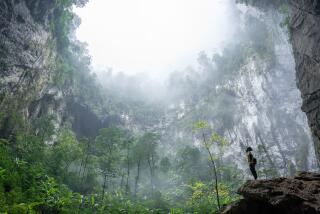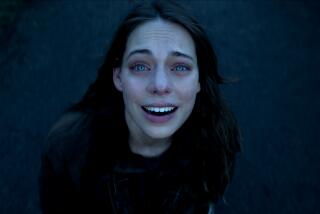‘Planet Earth’ viewers get close to nature
- Share via
A thousand feet above Van Nuys, J.T. Alpaugh sat in the rear seat of a news copter, joystick in hand, ready to show off the high-definition video camera that hung orb-like from the front of the aircraft.
“OK, see that car up there?” Alpaugh asked. “Next to the white truck?”
Two miles down Ventura Boulevard, a white speck crept across an intersection. Next to it was another, smaller white speck.
“Sort of,” said a reporter along for the ride.
“Right. Now watch the monitor,” said Alpaugh.
The helicopter’s high-definition video screen showed the same unremarkable view of Tarzana that could be seen outside the windshield. The long ribbon of Ventura Boulevard stretched into the distance, and the two white specks inched along. But as Alpaugh pressed a switch on his controller, the specks began to grow. And grow. And grow, until the smaller one had bloomed into an obviously alabaster white Mercedes E-class, featuring a blue California license plate whose letters and numbers were so vivid that both passengers read it aloud.
This camera system — called the Cineflex V14 — was designed by engineers at Cineflex, LLC, a division of the Van Nuys-based Helinet Group. The Cineflex takes a $90,000 high-definition camera and fits it with a telephoto lens capable of magnifying images to 84 times their actual size. But more than resolution or zoom length, what defines the Cineflex is its preternatural stability. The lens and sensor float inside a kind of gyro-stabilized bubble that does not move, no matter what the helicopter does. So even if the pilot drops into a steep turn through bumpy, stormy air, the image of that license plate won’t so much as flitter.
One of the first filmmakers to see the Cineflex’s potential was BBC nature producer Alistair Fothergill, the man behind “Planet Earth,” the 11-part, hi-def nature epic that premiered Sunday on the Discovery Channel. Fothergill saw that Cineflex’s tremendous range, resolution and stability could allow aerial teams to capture gorgeous, high-quality close-ups of animals without disturbing them. Moreover, using high-definition video meant air crews could finally ditch burdensome film cameras. No longer would helicopters have to land and reload every time a 10-minute film magazine ran out; now crews could stay aloft for hours, filming continuously.
“We suddenly saw, hang on, there are a series of animal behaviors out there which have not been filmable because [the old] cameras cannot keep up,” said Fothergill. But Cineflex could. “And that was clearly going to be revolutionary.”
The first episode of “Planet Earth” featured an extended hunting sequence in northern Canada. Helinet cinematographer Michael Kelem and his crew used a Cineflex to track wolves as they stalked migrating caribou. “As soon as they start running, you’re on them,” said Kelem, “You’re like a police helicopter in a car chase.”
Kelem was able to capture four wolf hunts in his first two hours, including one that ended in a prized “pull-down” — or kill. “The [camera] guys on the ground were going, ‘That’s better than we can do in two weeks!’ ”
Although filming wolf kills is a blast, it turns out not to pay much. So Helinet does a lot of work in Hollywood. Founder Alan Purwin — who for a while in the ‘80s was the guy who flew “Airwolf” — is a respected aerial coordinator who enjoys fruitful relationships with directors like Steven Spielberg, Tony Scott and Michael Bay. Cineflex-equipped copters are a filmmaker favorite because at some level, they can do just about anything. Helinet pilots can “park” in midair for static shots — Cineflex’s stability makes it look like the shot is taken from a steel crane — and perform dangerous and intricate stunt sequences, like the one Purwin did for the upcoming movie “Transformers” that involved flying four helicopters in tandem under the bridge on Cesar Chavez Boulevard in Los Angeles.
Back up above Tarzana, Alpaugh trained the camera on a poor sap speeding down the Ventura Freeway in an F-150 pickup.
“He has no idea we’re looking at him,” said Alpaugh, offering a comment on Cineflex’s other, more ominous application: surveillance. In the monitor, the driver’s face was so well defined you could tell he didn’t shave that morning.
It’s clear that aerial photography has come a long way since the days of the white Ford Bronco, when a momentary glimpse of shoulder was enough to keep viewers watching.
Law enforcement is a growing market. Helinet has partnerships with federal, state and local authorities as well as the work it’s done with “three-letter agencies.”
When it comes to Cineflex’s potential as a law-enforcement tool, though, Alpaugh and Purwin prefer to accentuate the positive. “Let’s say there’s an event with a lot of crowds,” explained Alpaugh. “An event that may be attractive as a terrorist target.”
Law-enforcement officials can then “look at people, look at expressions, look at clothing, look at backpacks — things you would normally look at if you were on the ground walking among these people.”
Kelem, the Helinet cinematographer who shot the wolf hunt, has an idea for a documentary: “I’d like to cut a tape where it’s animals chasing animals and police chasing criminals,” he said. “It’s like the same.”
Which is either amusing or insensitive — depending on your angle.
david.sarno@latimes.com
More to Read
The complete guide to home viewing
Get Screen Gab for everything about the TV shows and streaming movies everyone’s talking about.
You may occasionally receive promotional content from the Los Angeles Times.






